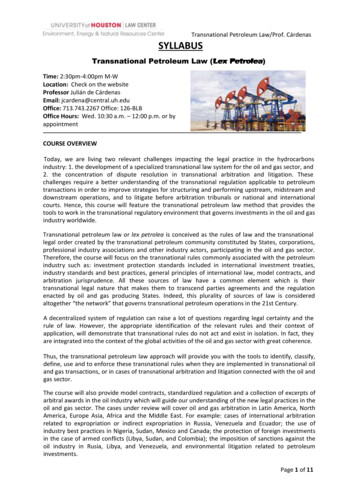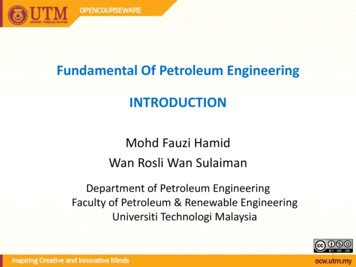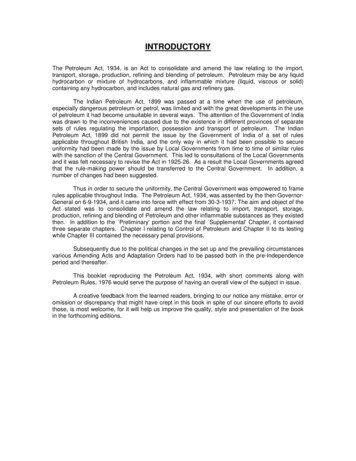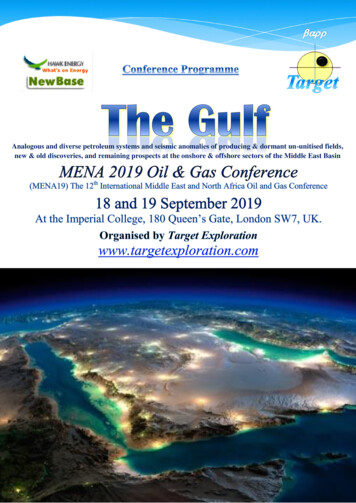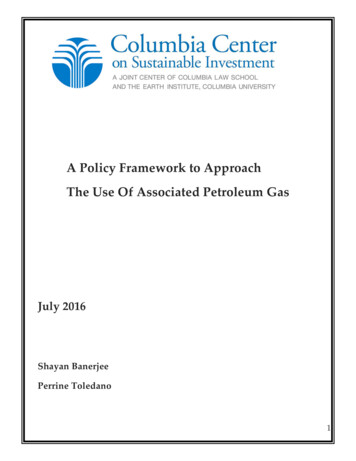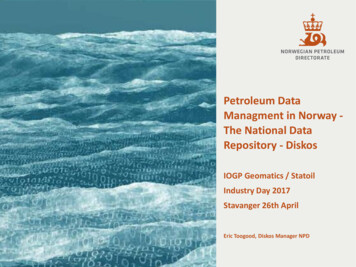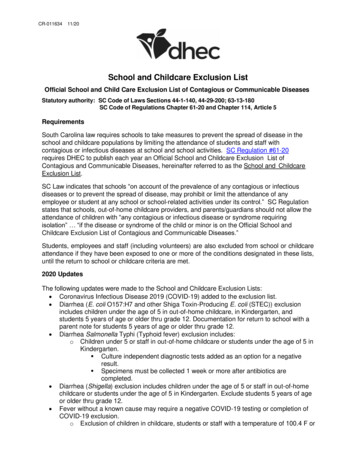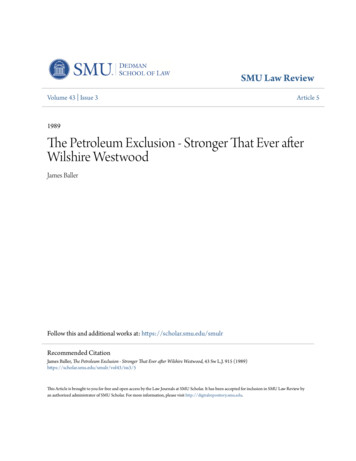
Transcription
SMU Law ReviewVolume 43 Issue 3Article 51989The Petroleum Exclusion - Stronger That Ever afterWilshire WestwoodJames BallerFollow this and additional works at: https://scholar.smu.edu/smulrRecommended CitationJames Baller, The Petroleum Exclusion - Stronger That Ever after Wilshire Westwood, 43 Sw L.J. 915 is Article is brought to you for free and open access by the Law Journals at SMU Scholar. It has been accepted for inclusion in SMU Law Review byan authorized administrator of SMU Scholar. For more information, please visit http://digitalrepository.smu.edu.
THE PETROLEUM EXCLUSION-STRONGERTHAN EVER AFTER WILSHIREWESTWOODbyJames Bailer*IL and natural gas are exempt from the Comprehensive Environmental Response, Compensation, and Liability Act of 1980(CERCLA or Superfund), as amended.1 Because of our society'swidespread use of oil and natural gas, this so-called "petroleum exclusion"affects not only the oil and gas industry, but also a broad cross-section of oureconomy. 2 The Environmenial Protection Agency (EPA) has observed thatthe petroleum exemption from the Superfund program is a major restriction3on the agency's authority at toxic waste sites.Tliroughout the last decade, EPA's national office has stated repeatedly4that the petroleum exclusion exists in the law and must be given effect.Similarly, virtually every court that has considered the exclusion has construed it broadly, often at EPA's own urging. 5 Yet, while some of EPA'sregional offices have applied the petroleum exclusion as written, other regional offices have either ignored the exclusion or advanced a variety of arguments to justify denying its benefits. One such argument is that evenwhere the exclusion concededly applies, the government can still imposeCERCLA-like strict, joint and several liability under other state and federal* A.B. Economics, Dartmouth College; J.D., Cornell Law School. Founder and principal litigator of Bailer Hammett, P.C., specializing in litigation, settlements, and counselingunder the major environmental statutes, particularly the Compenhensive Environmental Response, Compensation, and Liability Act. The author also has extensive experience in riskassessment and public health issues.1. Pub. L. No. 95-510, 94 Stat. 2767 (codified as amended at 42 U.S.C. §§ 9601-9675(1988)). CERCLA generally imposes strict, joint and several liability for the costs of responding to actual or potential releases of "hazardous substances" from a qualifying site upon pastand present owners and operators of the site, upon persons who arranged for disposal of hazardous substances at the site, and upon persons who transported hazardous substances to thesite. Id. §§ 9601(a)(14), 9604(a)(i), 9607.2. The federal government itself has not been reluctant to invoke the petroleum exclusion. See State of New York v. United States, 620 F. Supp. 374, 386 (E.D.N.Y. 1985).3. Brief for the United States as Amicus Curiae in Support of Appellees at 2, WilshireWestwood Assocs. v. Atlantic Richfield Corp., 881 F.2d 801 (9th Cir. 1989) (No. 88-5708).The brief stated that "[t]he statutory petroleum exclusion is one of the most significant restrictions on the response authority provided under the Superfund program for the cleanup of toxicwaste sites." Id.4. See infra notes 59-78 and accompanying text.5. See infra notes 44-57 and accompanying text.
SOUTHWESTERN LAW JOURNAL[Vol. 43laws, 6 including section 7003 of the Resource Conservation and Recovery7Act (RCRA).On July 31, 1989, EPA's General Counsel addressed this problem by issuing a comprehensive internal guidance document on the scope of the petroleum exclusion. 8 The General Counsel determined that the petroleumexclusion applies to all commercial forms of petroleum, including those thattypically contain hazardous constituents, so long as the petroleum has notbeen adulterated or contaminated during use by extraneous hazardoussubstances. 9The General Counsel's interpretation received its first test in the courts inWilshire Westwood Associates, Inc. v. Atlantic Richfield Corp.'0 The WilshireWestwood case involved the question of whether the petroleum exclusion applies to leaded gasoline. Upon learning of the General Counsel's interpretation, the district court reconsidered and reversed an earlier ruling that thepetroleum exclusion does not apply to leaded gasoline because it containslead, which is a "hazardous substance" under CERCLA in other contexts.'IWhen Wilshire Westwood reached the Ninth Circuit, it became the firstcase in which litigants fully briefed and argued the merits of the petroleumexclusion to a federal court of appeals. Recognizing the case's potentiallysignificant precedential effect, EPA filed a brief as amicus curiae in supportof the defendants. EPA argued that the statutory language, legislative history, agency interpretations, and policy considerations underlying the petroleum exclusion all required affirmance of the district court's decision.12 As aresult, many interested parties, including EPA itself, hoped that the NinthCircuit would issue a definitive interpretation of the scope of the petroleumexclusion that would have broad application elsewhere. While the NinthCircuit ultimately found that the petroleum exclusion applied to leaded gasoline,' 3 it stopped short of issuing the definitive interpretation that many ofthose interested had expected. For other parties relying on the exclusion inother contexts, however, the court's opinion does, in fact, provide some valuable guidance.6. Letter from F. Michael Thomas, Senior Assistant Regional Counsel, EPA Region I,to James Bailer (May 16, 1987) (discussing Petroleum Group's proposal regarding ranking ofpotentially responsible parties at the Cannons Engineering Superfund sites).7. Pub. L. No. 94-580, 90 Stat. 2826 (1976) (codified as amended at 42 U.S.C. §§ 69016987 (1988).8. Memorandum from Francis S. Blake, EPA General Counsel, to J. Winston Porter,Assistant Administrator for Solid Waste and Emergency Response, Scope of the CERCLAPetroleum Exclusion Under Sections 101(14) and 104(a)(2) (July 31, 1987) [hereinafter General Counsel's Memorandum] reprinted in 14 Chem. Waste Litig. Rep. (Computer L. Rep.)842 (1987).9. Id at 844-47.10. 27 Env't Rep. Cas. (BNA) 2146, 2146-47 (C.D. Cal. 1987), rev'gon reconsideration,27Env't Rep. Cas. (BNA) 1800 (C.D. Cal. 1987), aff'd, 881 F.2d 801 (9th Cir. 1989).11. 27 Env't Rep. Cas (BNA) at 2146-47.12. See supra note 3.13. 881 F.2d at 804-05.
THE PETROLEUM EXCLUSION1990]I.EVOLUTION OF THE PETROLEUM EXCLUSION BEFOREWILSHIRE WESTWOODA. Legislative HistorySince 1980, Congress has considered regulating releases of petroleum intothe environment in several different contexts. On each occasion, Congresshas expressly declined to subject responsible parties to CERCLA-like strict,joint and several liability. Congress has adopted some alternatives, and congressional leaders' explanations for these alternatives are difficult to reconcile with the notion that Congress believed CERCLA-like liability forreleases of petroleum could already be imposed under section 7003 ofRCRA.When Congress enacted CERCLA in 1980, it made the term "hazardoussubstance" the operative term for the purposes of the response and liabilityprovisions of the Act. 14 In section 101(14),15 Congress defined the term"hazardous substance" as one specifically listed or designated as hazardousunder any of several other environmental statutes identified in subsections(A) through (F) of that section. 16 Because Congress did not specifically listor designate crude oil, most refined petroleum products, and natural gas, ashazardous under the named statutes, it need not have gone further to exemptoil and natural gas from CERCLA. Nonetheless, to emphasize its intent toexclude oil and natural gas from CERCLA, Congress concluded section101(14) with a proviso that petroleum (including crude oil and any fractionof crude oil) not otherwise specifically listed or designated as hazardous wasnot a hazardous substance. In addition, the term "hazardous substance" didnot include natural gas, natural gas liquids, liquified natural gas, or synthetic17gas usable for fuel.14. 42 U.S.C. §§ 9603, 9604(a)(1), 9607.15. Id. § 9601(14).16. "Hazardous substance" means (A) any substance designated pursuant to section 31 l(b)(2)(A) of the Federal Water Pollution Control Act, (B) any element,compound, mixture, solution, or substance designated pursuant to section 102 ofthis Act, (C) any hazardous waste having the characteristics identified under orlisted pursuant to section 3001 of the Solid Waste Disposal Act (but not including any waste the regulation of which under the Solid Waste Disposal Act hasbeen suspended by Act of Congress), (D) any toxic pollutant listed under section307(a) of the Federal Water Pollution Control Act, (E)any hazardous air pollutant listed under section 112 of the Clean Air Act, and (F) any imminentlyhazardous chemical substance or mixture with respect to which the Administrator has taken action pursuant to section 7 of the Toxic Substances Control Act.The term does not include petroleum, including crude oil or any fraction thereofwhich is not otherwise specifically listed or designated as a hazardous substanceunder subparagraphs (A) through (F) of this paragraph, and the term does notinclude natural gas, natural gas liquids, liquefied natural gas, or synthetic gasusable for fuel (or mixtures of natural gas and such synthetic gas).Id.17. Id. Under § 104(a)(1), 42 U.S.C. § 9604(a)(1), response actions could also be triggered by releases or substantial threats of releases of any "pollutant or contaminant which maypresent an imminent or substantial danger to the public health or welfare. . ." In § 101(33),42 U.S.C. § 9601(33), Congress also excluded petroleum from the definition of "pollutant orcontaminant," using virtually the same language as it had used in § 101(14).
SOUTHWESTERN LAW JOURNAL[Vol. 43Congress did not define the terms "petroleum," "fraction," or "naturalgas" in CERCLA, nor did the legislative history go into much detail. Infact, the Wilshire Westwood court noted that the legislative history was nothelpful in determining the scope of the petroleum exclusion.' 8 Still, muchcan be learned from what Congress has done or failed to do about petroleumduring the last decade, and the debates surrounding the enactment of CERCLA in 1980 are an essential starting point.CERCLA was the product of a last-minute congressional compromiseamong three competing bills.' 9 On the House side, H.R. 7020, the Hazardous Waste Containment Act, focused on remedying pollution from chemicaldumps on land and did not cover spills of petroleum. Petroleum spills werethe subject of a separate, companion bill, H.R. 85, the Oil Pollution andCompensation Act. The leading bill in the Senate was S. 1480, the Environmental Emergency Response Act, which provided for "an ambit of liabilitysignificantly larger than that under H.R. 7020." This bill, however, did notcover petroleum. 20 The House of Representatives sent H.R. 7020 and H.R.85 to the Senate but the latter bill died. 2 ' Thus, both the House and Senateexcluded petroleum, as did the legislabills remaining under consideration22tion Congress ultimately passed.In the debates on the compromise bill, several members of Congress expressed concern about the lack of authority under the bill to respond to releases of petroleum. Typical of these responses were the comments ofRepresentative Mikulski of Maryland. Representative Mikulski was prepared to accept Senate assurances of future consideration of an oilspill proposal in order to secure swift passage of legislation dealing with abandoned18. Wilshire Westwood, 881 F.2d at 805. The court stated that "ft]here is virtually nolegislative history contemporaneous with the enactment of CERCLA directly relevant to thescope of the petroleum exclusion." Id.19. Id. at 805-06; Dedham Water Co. v. Cumberland Farms Dairy, Inc., 805 F.2d 1074,1081 (1st Cir. 1986); United States v. Mottolo, 605 F. Supp. 898, 902-05 (D.N.H. 1985). Foran extensive history of the 1980 debates on CERCLA, see Grad, A Legislative History of theComprehensive Environmental Response, Compensation and Liability ("Superfund") Act of1980, 8 COLUM. J. ENVTL. L. 1 (1982).20. Grad, supra note 19, at 7, 22. The Senate Report accompanying S. 1480, S. REP. No.848, 96th Cong., 2d Sess. 29, 30-31 (1980) explained only that:[P]etroleum, including crude oil and including fractions of crude oil which arenot otherwise specifically listed or designated as hazardous substances undersubparagraphs (A) through (F) of the definition, is excluded from the definitionof hazardous substance. The reported bill does not cover spills or other releasesstrictly of oil. It is also important to note that natural gas, liquified natural gas(LNG), and high BTU synthetic gas of pipeline quality (or mixtures of naturalgas and such synthetic gas) are not considered hazardous substances within thepurposes of S. 1480.21. Grad, supra note 19, at 4.22. The final compromise bill was called H.R. 7020 because the Superfund legislation wasa revenue measure that had to originate in the House. Id. at 29. In fact, however, the billconsisted of the enacting clause of H.R. 7020 and the substance of S. 1480, as amended by theSenate. The House considered and adopted the bill under a suspension of the rules, which inthis case meant that it had no opportunity to offer amendments. Id. at 29-30. "Faced with acomplicated bill on a take-it-or-leave-it basis, the House took it, groaning all the way.". Id. at
1990]THE PETROLEUM EXCLUSIONtoxic waste sites. 2 3In 1984, in the course of amending and reauthorizing RCRA, Congresshad another opportunity to consider legislation to address releases of petroleum.24 Again, Congress declined to subject persons responsible for releasesof petroleum to CERCLA-like liability. Instead, it opted for more limitedremedies tailored to the specific problems before it.25One of Congress's main concerns in 1984 was leakage from undergroundstorage tanks, particularly those containing petroleum, which Congress considered a major source of groundwater pollution.26 Because of the petroleum exclusion, however, Congress believed that under the Superfundauthority, the federal government could neither respond to nor cleanup apetroleum products spill. 27 Congress responded not by eliminating or weakening the petroleum exclusion, but by enacting a new managementprogram28for underground storage tanks under subtitle I of RCRA.Similarly, Congress's treatment of used oil in the 1984 amendments toRCRA reflected its reluctance to impose CERCLA-like liability on personsresponsible for releases of petroleum. In 1984 an EPA report had noted thatused automotive and industrial oils typically contain heavy metals and nu23. Typical of these responses are the comments of Representive Mikulski of Maryland:The Senate bill is substantially similar to the House measure, with the exceptionthat there is no oil title.I realize that it is disappointing to see no oil-related provision in the bill, butwe must also realize that this is our only chance to get hazardous waste dumpsite cleanup legislation enacted. I would note that we have had assurances fromMembers of the Senate that an oilspill proposal would be considered a very highlegislative priority in the 97th Congress.Moreover, there is already a mechanism in place that is designed to deal withspills in navigable waterways. There is not, however, any provision currently inour law that addresses the potentially ruinous situation of abandoned toxicwaste dump sites.I, therefore, believe that it is very imperative that we pass the Senate bill as avery important beginning in our attempt to defuse the ticking environmentaltime bomb of abandoned toxic waste sites.'126 CONG. REc. 31,976 (1980); see also 126 CONG. REc. 31,964, 31,968 (1980) (statement ofRep. Florio); id. at 31,969 (statement of Rep. Broyhill); id. at 31,970 (statement of Rep.Breaux); id. at 31,971-72 (statement of Rep. Biaggi); id. at 31,975 (statement of Rep. Snyder).24. Hazardous and Solid Waste Amendments of 1984 (HSWA), Pub. L. No. 98-616,§§ 101-704, 98 Stat. 3221, 3224-93 (1984) (codified as amended at 42 U.S.C. §§ 6901-6991(1988)) (amending the Resource Recovery and Conservation Act of 1976, Pub. L. No. 94-580,§§ 1001-8007, 90 Stat. 2795, 2795-841 (1976) (codified as amended at 42 U.S.C. §§ 6901-6987(1988)) (amending the Solid Waste Disposal Act of 1965 (originally enacted as Pub. L. No. 89272, 79 Stat. 997 (1965))).25. See supra notes 28-34.26. See 130 CONG. REc. § 2028 (daily ed. Feb. 29, 1984) (statement of Sen. Durenberger).27. Senator Durenberger stated that "the Federal Government cannot under Superfundauthority respond or clean up a spill if it involves petroleum products." 130 CONG. REc.§ 2028, 2080 (daily ed. Feb. 29, 1984) (statement of Sen. Durenberger), quoted in WilshireWestwood, 881 F.2d at 807; see also 130 CONG. REc. 20,826-30 (1984) (statement of Sen.Durenberger) (discussing proposed amendment to protect groundwater sources from leakingunderground storage tanks); Id. at HI 1,141-42 (daily ed. Oct. 3, 1984) (statement of Rep.Florio) (requesting unanimous consent to consider an amendment to RCRA); id. at HI 1,1143(statement of Rep. Eckhart supporting Rep. Florio's amendment); id. at Hi 1,144 (statement ofRep. Ritter) (supporting Rep. Florio's amendment).28. Section 601(a) of HSWA added Subtitle I to RCRA, 42 U.S.C. §§ 6991-6991i.
SOUTHWESTERN LAW JOURNAL[Vol. 43merous other toxic constituents. 29 Concerned by this report, Congress in1984 gave EPA one year (until November 6, 1985) to propose whether to listor identify used automobile and truck crankcase oil as hazardous wastesunder RCRA, and two years (until November 8, 1986) to make a final determination whether to list or identify used automobile and truck crankcase oiland other used oils as hazardous wastes. 30 As EPA promptly recognized,the effect of listing used oils as hazardous wastes under RCRA would be tosubject used oils to CERCLA liability for the first time. 3 1 Thus, once again,instead of merely eliminating the petroleum exclusion or limiting its scope,Congress chose a cautious, narrowly-focused alternative to avoid imposingCERCLA-like liability unless absolutely necessary.The special treatment of petroleum under the 1984 amendments to RCRAis even more significant when seen in the light of Congress's simultaneousrevision of section 7003(a) of RCRA. 32 By this revision, Congress clarifiedthat the government had authority under that provision to impose CERCLA-like liability upon non-negligent off-site generators of hazardouswastes. 33 Had Congress believed that section 7003, from its inception, retroactively imposed strict, joint and several liability on persons responsible forreleases of petroleum, then Congress would have had no need to enact acomprehensive new management program in 1984 for underground storagetanks containing petroleum. Moreover, several key members of Congresswould not have sought to justify that program as being necessary to fill a gapcreated by the petroleum exclusion. 3 4 Likewise, Congress would not haveneeded to require EPA to go to great lengths to determine whether listingused oils as hazardous wastes under RCRA was necessary as a first steptoward imposing strict, joint and several liability under CERCLA.Two years later, in the Superfund Amendment and Reauthorization Act29. EPA, Listing of Waste Oil as Hazardous Waste 43-70 (Jan. 1981) (cited in 17 Chem.Waste Litig. Rep. 3 (Computer L. Rep.) (1988)).30. A new § 3014(b) of RCRA, 42 U.S.C. § 6935(b), which was added by § 242 ofHSWA, contained these requirements and deadlines.31. In response to § 3014(b), EPA solicited public comments on listing used oil as a haz-ardous waste and stated, "used oil will become a hazardous substance under the Comprehen-sive Environmental Response, Compensation and Liability Act (CERCLA) as a result oftoday's [proposed] listing . . . " 50 Fed. Reg. 49,258, 49,258 (proposed Nov. 29, 1985).32. See H.R. CONF. REP. No. 1133, 98th Cong., 2d Sess. 119 (1984), reprinted in 1984U.S. CODE CONG. & ADMIN. NEWS 5649, 5690; see also United States v. Northeastern Pharmaceutical & Chem. Co., 810 F.2d 726, 732-33 (8th Cir. 1986) (discussing congressional intentfor retroactive application of CERCLA), cert denied, 484 U.S. 848 (1987).33. H.R. CONF. REP. No. 1133, 98th Cong., 2d Sess. 119 (1984).34. In the debates on the new Subtitle I of RCRA, Senator Durenberger noted:[Tjank storage of one of the most common groundwater contaminants--gasoline-is unregulated because it is not waste product (and thus not under theauthority of the Resource Conservation and Recovery Act), and spills of the fuelcannot be cleaned up under the Superfund law because it is a petroleumproduct.130 CONG. REC. 3834 (1984) (emphasis added). Senator Durenberger apparently did not understand that releases of petroleum from underground storage tanks could be remedied by§ 7003 of RCRA, and no other member of Congress suggested otherwise.
1990]THE PETR OLE UM EXCLUSIONof 1986 (SARA), 35 Congress forcefully underscored its strong support forthe petroleum exclusion by re-enacting the exclusion without change. Tounderstand the full import of this action, it is useful to consider the evolutionof Congress's thinking about the problem of leaks from underground storagetanks.By 1986, Congress had concluded that a new management program undersubtitle I of RCRA could not adequately address the problem of leaks ofpetroleum from underground storage tanks. 36 Nevertheless, Congress stillbelieved that the petroleum exclusion denied the government authority toaddress such leaks. 37 As in 1984, Congress responded by dealing directlywith the problem before it, while leaving the petroleum exclusion intact.In the floor debates leading to the enactment of SARA, Senator Simpson 38advised his colleagues that the bill would not reduce the reach of the petroleum exclusion, 39 which applied to a wide variety of petroleum-related products.40 In the House, Representative Hall similarly explained the bill. 41With this knowledge, both houses of Congress reaffirmed the exclusion as ithad previously been in effect. To address the problem of leaks from underground storage tanks, Congress added a new response program to subtitle Iof RCRA, supported by a 500 million Underground Storage Trust Fund. 42B. Court DecisionsBefore the Ninth Circuit decided Wilshire Westwood, the petroleum exclusion had been the subject of district court decisions in a variety of factualsettings.43 While none of these district courts had the benefit of a full recordand the extensive briefing that the parties submitted to the Ninth Circuit inWilshire Westwood, virtually all reached the same conclusion as the WilshireWestwood court: Congress intended the courts to apply the broad statutorylanguage of the petroleum exclusion as written.For example, in Eagle-PicherIndustriesv. United States EPA " the courtaccepted -EPA's argument that if Congress had wanted to carve out a"broad" and "general" exception from CERCLA for mining wastes and fly35. Pub. L. No. 99-499, 100 Stat. 1613 (codified as amended at 42 U.S.C. §§ 9601-9675(1988)).36. 132 CONG. REC. 9599 (1986) (statement of Rep. Roe); id. at H9572 (statement of Rep.Strangeland); id. at 9625 (statement of Rep. Ekhart).37. Id.38. Senator Simpson was ranking member of the committee that prepared the Senate bill.Grad, supra note 19, at 7-8.39. 132 CONG. REc. S14,932 (daily ed. Oct. 3, 1986) (statement of Sen. Simpson). SenatorSimpson stated that the bill would "not diminish the scope of the present petroleum exclusion." Id.40. Id. Senator Simpson explained that the exclusion applied to "all types of petroleum,including crude oil, crude oil tank bottoms, refined fractions of crude oil, and tank bottoms ofsuch which are not specifically listed or designated as such under the other subparagraphs ofthat provision [section 101(14)]." Id.41. Id. at H9605 (statement of Rep. Hall).42. Section 205 of SARA added the new subsection 9003(h), 42 U.S.C. § 699lb(h), toSubsection I of RCRA.43. See infra notes 44-57.44. 759 F.2d 922 (D.C. Cir. 1985).
SOUTHWESTERN LAW JOURNAL[Vol. 43ash, it could have done so explicitly, as it had for petroleum. 45 Similarly, inUnited States v. Metate Asbestos Corp.4 6 the court found that if Congress hadwanted to exclude asbestos wastes completely from CERCLA, then Congress would have incorporated the exclusion into the petroleum and naturalgas exclusion. 47In The Marmon Group, Inc. v. Rexnord, Inc.48 the court applied the petroleum exclusion to "waste cutting oil" used in the manufacture of gears. 49The Marmon Group court held that cutting oil fell within the petroleumexclusion and thus was excluded specifically from CERCLA section9601(4)'s definition of the term hazardous substance. 50 In City of Philadelphia v. Stephan Chemical Co.,51 the court broadly applied the exclusion to"petroleum products," and in United States v. Alexander5 2 the court dismissed a third-party action and denied various discovery requests against adefendant whose contribution to a Superfund site consisted solely of crudeoil-tank bottoms.In United States v. Wade5 3 the court observed that it would be inconsistent to define hazardous substance in such a way as to exclude fuel oil andthen treat fuel oil as hazardous because it contained hazardous constituents.In New York v. United States5 4 the Justice Department argued on behalf ofthe Secretaries of Defense and the Air Force that jet fuel was exempt fromCERCLA even though it contained small amounts of CERCLA hazardoussubstances such as benzene, toluene, and xylene. The court found the argument appealing, but did not reach the issue.5 5 Similarly, in the more recentdecision of City of Philadelphiav. Stepan Chemical Co.56 the court, relyingupon the EPA General Counsel's Memorandum of July 31, 1987, acceptedas true for the purpose of a motion for summary judgment that oil, grease,phenol, and benzene produced from the distillation of petroleum fall entirely57within the petroleum exclusion.45. Id. at 927, 932; see also United States v. Union Gas Co., 586 F. Supp. 1522, 1524(E.D. Pa. 1984) (if Congress had intended subsection C of § 101(14) to exclude mining wasteand fly from CERCLA, "it would have placed the subsection (C) limitation in the separatesentence concerning the general exclusion for petroleum and gas").46. 584 F. Supp. 1143 (D. Ariz. 1984).47. Id. at 1147.48. No. 85-C-7838 (N.D. Ill. June 16, 1986).49. Id., slip op. at 2.50. Id. On appeal, the Seventh Circuit reversed on other grounds, but noted and let standthe portion of the district court's opinion dismissing the CERCLA count on the basis of thepetroleum exclusion. The Marmon Group, Inc. v. Rexnord, Inc., 822 F.2d 31, 33 (7th Cir.1987).51. No. 81-0851, slip op. at 1 (E.D. Pa. Aug. 11, 1982) (unpublished).52. C.A. No. G-86-267 (S.D. Tex. Sept. 16, 1987) (unpublished).53. 14 Envtl. L. Rep. (Envtl. L. Inst.) 20,440-41 (E.D. Pa. Apr. 27, 1984).54. 620 F. Supp. 374 (E.D.N.Y. 1985).55. Id. at 386.56. No. 81-0851, slip op. at 2 (E.D. Pa. Dec. 9, 1988).57. In one other case, State v. Time Oil Co., 687 F. Supp. 529, 531-33 (W.D. Wash. 1988),the court held, without discussing the petroleum exclusion, that waste automotive crankcaseoil contaminated with lead, cadmium, and chromium was a "hazardous substance" underCERCLA.
1990]THE PETROLEUM EXCLUSIONC. EPA InterpretationsDuring the last decade, EPA has interpreted the petroleum exclusion expansively in numerous public notices and interpretations. 58 For example, ina FederalRegister notice announcing CERCLA notification requirements,EPA stated that irrespective of their status under RCRA, "waste oils" didnot come within the definition of Superfund.5 9 In a subsequent notice announcing changes to these notification requirements, EPA said that the exclusion would apply to crude oil, petroleum feedstocks, and refinedpetroleum products. Moreover, EPA stated that the exclusion would stillapply despite the presence of a specifically listed substance in suchproducts.6oAgain, in a proposal made in November 1985 to list certain used oils ashazardous wastes under RCRA, EPA recognized that such used oils, whichit believed to be highly toxic, had not previously been subject to CERCLA. 6 1In a further notice soliciting additional comments on its proposal to list usedoil as a hazardous waste under RCRA, the agency retreated somewhat andsuggested that CERCLA may already apply to used oils. The EPA stated,however, that CERCLA would apply only to oils with levels of hazardoussubstances in excess of those typically found in petroleum. 62 More recently,when EPA proposed regulations to implement the underground storage tankprogram, it stated that the release of petroleum from underground storage63tanks or other sources was not subject to CERCLA.Similarly, EPA's office of General Counsel has read the petroleum exclusion liberally in three internal guidance documents. In the first, the GeneralCounsel used language strikingly similar to that of the Wade court in holding that denying the benefits of the petroleum exclusion to diesel fuel, because it commonly contains benzene and tolune, would vitiate the petroleumexclusion and defeat legislative intent.64 Instead, the General Counsel foundthat CERCLA must not be applied to hazardous substances inherent in petroleum fractions, but should be applied only to those hazardous substancesthat are combined later with the petroleum product by way of adding or58. See infra notes 59-63.59. 45 Fed. Reg. 22,145 (Apr. 3, 1980).60. 50 Fed. Reg. 13,460 (1985). The agency observed, however, that the petroleum exclusion would not apply to waste oil "to which listed CERCLA substances have been added." Id.61. 50 Fed. Reg. 49,258, 49,26
Wilshire Westwood Associates, Inc. v. Atlantic Richfield Corp.'0 The Wilshire Westwood case involved the question of whether the petroleum exclusion ap-plies to leaded gasoline. Upon learning of the General Counsel's interpreta-tion, the district court reconsidered and reversed an earlier ruling that the


